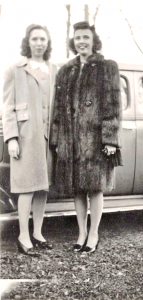From her earliest days, Marcella “Marcy” Kroupa McMahon, had a California dream. The La Palma resident turns 100 years old this week, never once defying the inscrutable sense of style that has defined her life.
Marcy was born on Friday, Dec. 10, 1920 in the Twin Cities of Minnesota. A gallon of milk cost 35 cents, Woodrow Wilson was in the White House, Warren Harding was President-elect and women had gained the right to vote only four months earlier with the passage of the 19th Amendment to the U.S. Constitution.
Since then, Marcy has experienced so much living history, including making a bit of it on her own as part of one of the original generations to venture out west to make their dreams come true.
She entered life during a pandemic and becomes a celebrated centenarian during another, having watched women struggle through decades in a quest for equal rights.
As a public service to the city of La Palma, which celebrated its 65th Anniversary in October, Marcy agreed to write a memoir of her days in the city. With her family’s permission, we herein tell her story.
Her mom, Tillie Worshek, and dad, Frank Kroupa, were both of Czech- Bohemian origin living in Minnesota after immigrating from Eastern Europe
“Some of my shirt-tale family was born on the Atlantic Ocean,” said Marcelle, “crossing over from Europe to USA, on one of the many trips made by the Titanic ocean liner.”
Luckily, though many of her family had made the Titanic crossing, there were no family members aboard the fateful night it sank.
As a child, she remembered how her family was affected by the nation’s first pandemic. It was “sad,” she remembers, because “the pandemic took some members of my family.”

Courtesy photo
At 20, Marcy graduated college in Minnesota, with honors, then immediately “headed out west” to find employment.
Even with a college degree, Marcy remembers life was not at all easy if you were a woman.
“Back then, since I was a single woman, could not get a driver’s license, nor purchase a car, or enter into a rental or purchase contract,” she remembered, “so I relied on the public transportation and lived with relatives and was a roommate at various homes in beautiful Los Angeles.”
Back then, she said, “females had just (been) given right to vote” a few years earlier.
When Marcy arrived in Los Angeles in the early 40’s, Long Beach, Santa Monica, and Pasadena were already established, she said, but Beverly Hills was “still a small an upcoming community” and there was no Disneyland (it did not open until 1954).
“Most homes were decorated in accent hues of pink, or copper, avocado green and harvest gold,” said Marcy, along with “glass accessories and pot-belly stoves.”
Furniture was either hand-made or imported from Europe, her story contends.
“Most homes had milk delivery and ice doors, since few homes had refrigeration,” she said. Hardwood floors and hallway phone booths were in most homes.
The local economy, like the entire nation, was healing slowly from the Great Depression. World War II had ended, yet “men were still missing from the war,” she said.
On a “personal note,” Mrs. McMahon said “I lost a few boyfriends along the way. They were killed in the war.”
Then came a polio epidemic that tragically affected other members of her family. “They had surgery to reverse the crippling disease.” Their family then mostly lived in the Downey, South Gate area.
“I met my late husband Raymond McMahon, in the late 1940s, in Los Angeles, married in the city of South Gate, California, and moved into a new model home in the city of Downey,” she said.

She and Raymond had four children that were raised in Downey, two of whom passed away. After the Watts Riots, said Marcy, “we decided Downey was not for us.”
By now, the baby boom was in full swing and the family was very happy in their new executive home in South Bay Palos Verdes. “We were both employed in South Bay for many years,” she said, after the post-war economy began to create many jobs.
“We loved raising our family in Palos Verdes, since employment pulled us both in that direction; except the weather was unpredictable,” said Marcy, and “with long, long commutes to Los Angeles and Orange County.”
Back then, she said, both the 605 freeway and the 405 were both still under construction.
“So, we decided to move to Cerritos-La Palma, California,” said Marcy.
“We were attracted to the city of Cerritos-La Palma because one of our former neighbors lived in the South Bay and then moved to Cerritos and became a council person for Cerritos,” she said. “He was a great salesman,” said Marcy.
They purchased the home in which Marcy currently lives in 1974, literally on the La Palma/Cerritos border “and been here ever since.” The still disputed border runs through their property, said Jim, and even today, she gets tax notices from La Palma, Cerritos and Orange County.
Although Marcy ended up with an “enchanted” garden at her hideaway cottage home, it was not easy.
“The soil was not very good,” she said, given the fact that the home had originally sat on a horse ranch, “so a lot of the plants burnt from the soil contamination.”
Marcy “it’s taken 50 years to leach out the soil,” but today some of her plants are more than 50 years old and still thriving. “Many of the plants came from Kitano’s Nursery in La Palma, Andy’s Nursery in Artesia, Roger’s in Newport Beach and even some from Begonia Farms in Palos Verdes.
Always dressed to the nines, Marcy was a trained legal secretary and like the precision of the law, she demanded proper English and living life to the fullest, as she defined it in every way.
Once they moved to La Palma, Marcy remembers that her husband Ray eventually worked in the early 2000’s for the City of Cerritos. “He enjoyed it,” she said.
Sadly, Marcy was in Beverly Hills when she learned of the sudden death of her husband Ray in 2002.
She compares his death with COVID-19 victims in that she was not with him when it happened. “I feel for all families, when they are not at the bedside of their mate dying.”
Since then, she has enjoyed living in La Palma/Cerritos with her two sons. She still enjoys the RV, even if today in a different way. “We enjoy having the RV on the side yard of the house. It’s like having a mobile guest house next to the house.”
“Most of my friends in Cerritos, La Palma, and Cypress have either moved away or have passed on.” In Downey, same story. “They’ve all passed away.”
According to Marcy’s account, most of her family members have moved to Colorado. “Both sides of the family,” she said. “They have shut the doors forevermore to California.”
“At one time, I had more than 400 relatives in California from both sides of the family, but that number doesn’t exist anymore, family sizes are reduced to zero or have not reproduced.”
She said they tried doing a family reunion in each state every five years, but “the attendees are reducing.”
Asked if she wanted to travel back to Minnesota “for one last hello,” Marcy replied, “no thank you, no one left there anymore.”
“I have outlived my clans and I am the oldest living on both sides,” she states. And, says Marcy, “it’s easy to be forgotten when you’re older.”
“Things mom took for granted back then, today’s world is too busy to put them in place,” according to her son Jim, who lives with her and said he was also speaking for him and his brother Ken. Jim says there were four children, but two have passed on.
They grew up in a household much different than those of today, he said, noting that culture has been transformed significantly from the lavish dinner parties in the backyard where neighbors openly and freely came over to enjoy.
“We live in a world of abandoned protocol, culture and society from how mom’s generation viewed life,” he noted. While many East European immigrants suffered from a communications problem, Jim says Marcy was fortunate that her dad knew how to speak English and taught it to her early on.
“My mom would never settle” for less than what she wanted, says Jim. “When she dressed us for school, we could never be seen in the same outfit in the same semester,” he said.
Marcy “wore a lot of hats,” he said, partly to keep her hair dust free and she wore longer dresses so “not to receive ankle biters from mosquitos.”
With smooth skin as a centenarian, her son knows why. “Mom never washed her face,” said Jim, adding “she always used creams to cleanse her skin. To this date, her face has never seen a drop of water.”
Jim says his mother “always knew how to behave around food,” always saying “I can’t eat that much” before cutting her portion in half.
In her own account, even at 100, Marcy says she takes no meds, “not even aspirin.” However, she does reveal “my hearing is not as sharp as yesteryear.”
Since the current pandemic, “my life has been home bound. It kind of reminds me of staying home under cover during World War II.”
Marcy says she prays the Rosary often since she cannot attend St. Hedwig’s Catholic Church.
“When God is ready for me to come home, Orange County will be my final resting place,” she says, “next to my husband and a few cousins.” She says most family members were laid to rest in Minnesota. “I will be one of the few to break the chain.”
Until then, Marcy sits with her “tea-cup dog Coco” and watches the COVID world go by, still comfortable, still uncompromising and with the same style that has been her hallmark.
She has lived through cultural shifts, the birth of the Internet, moon landings, and the list goes on. From her account, it is obvious how much the world has changed since she ventured out to California to live out her dream. Much has been gained while much has also been lost.
In 1950, there were only a handful of centenarians in the USA and although there are many more today, Marcy knows on Wednesday she joins an exclusive club. “Less than one percent of the people in the USA lives to be a centenarian,” says Marcy. “That calculates to about 75,000 of us oldies like me.”
“Cheers.”
Editor’s Note: Marcella’s entire memoir is posted to the City of La Palma’s website under the 65th Anniversary section.













